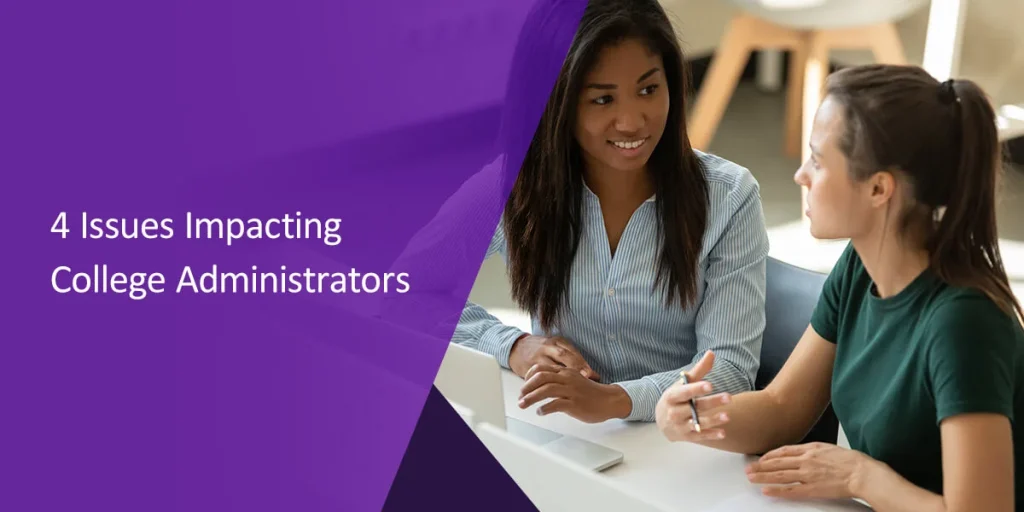
Administrators are responsible for managing and organizing many essential campus functions. When issues arise, they are often the ones who must respond and find solutions. When you want to streamline your responses and find the right solutions for your institution, understanding common problems facing administrators nationwide can prepare your administrative teams.
4 Issues in Higher Education That Administrators Are Facing
Higher education institutions have unique needs that the administration must handle and manage to maintain a healthy, safe, and productive learning environment for their students and faculty. When your administrative teams want to drive improvement at your institution, understanding the common issues on college campuses can identify areas where you can focus initiatives.
1. Diverse and Evolving Student Needs
Higher education institutions have diverse student bodies that include various student populations and groups. Each group has unique needs and priorities, making it challenging for administrators and institutions to meet the needs of each student and demographic on campus.
However, failure to meet student needs and improve students for various populations on campus can decrease satisfaction for impacted students. Schools might see an increase in dropout and transfer rates.
When considering student needs, keep these populations in mind:
- Commuters
- Graduate students
- Minority groups, like students of color and LGBTQ+ students
- Low-income students
Proactive measures to include the needs of minority students and vulnerable groups help ensure your campus makes decisions with every student in mind. Anticipating needs can help when the needs of students change, so your school can better react and adjust.
2. Need for More Comprehensive Mental Health Services

Mental health in college students is declining. In 2021, around 60% of college students reported fitting the criteria for at least one mental illness. However, many feel unsupported by their campuses and their available services. Many institutions offer on-campus counseling services, but these programs are in high demand — counselors can only see so many students and might already be taking on higher workloads to accommodate increasing needs.
With rising mental health crises, students need more comprehensive mental health centers to match their needs. More available counselors can support more of the student body, creating shorter waitlists and offering faster assistance for students who need it. Expanding your services can also open opportunities to bring in more individuals with diverse specialties, allowing your on-campus services to accommodate mental illnesses and conditions beyond anxiety and depression.
Improving services and management for mental health facilities can also benefit your counselors. When they have fewer students to manage, they can reduce the risk of burnout and fatigue, allowing them to serve your student population better.
3. Undersupported Workforce and Faculty
Labor shortages are causing several industries to reassess their employee benefits and treatment, including the higher education sector. Campuses are bustling with various employees, from students working as assistants in offices and dorms to faculty researchers and administrative teams. Schools rely on these individuals to maintain regular operations across departments and student services.
Many employees feel they need to be more supported and valued by their institution, causing them to leave and seek out competing schools or other careers. Schools can counteract this by offering competitive salaries and comprehensive benefits for faculty and staff while also working to boost morale and appreciation.
4. Rising Tuition Rates
Recent generations are facing unprecedented education costs to receive the degrees needed to enter the workforce. In 2021, the average cost of attending a higher education institution reached over $28,700, which is a 180% increase from the costs to get the same services and level of education in 1980.
Tuition rates make schooling unattainable for many low-income students or increase their risk of dropping out. Many students rely on alternative measures to afford education, including taking out student loans with high-interest rates, working multiple jobs, or relying on financial aid.
Supporting these students can boost student retention and satisfaction at your higher education institution. You can implement many strategies to improve student success for those struggling financially, including:
- Clarifying financial aid eligibility requirements and application due dates.
- Offering more stipends to fit student needs.
- Providing comprehensive financial advisory services.
- Waiving unpaid fines for graduating students.
- Supporting used and ebook sales at the start of semesters.
Because many administrators can drive campus-wide improvements, tackling affordability issues can help you maintain student retention and satisfaction rates.
What College Administrators Can Do
When facing challenges on your campus, higher education administrators can implement various strategies to tackle problems and foster campus-wide improvements.
Understand Your Student Population
When campuses are so diverse and comprehensive with various groups and populations, you can better meet their needs by understanding who comprises your campuses. Breaking down your student population and collecting data on student demographics can help you discover underrepresented groups with unmet needs. You can better target various groups when you know who is present on your campus with your initiatives.
Data collection can also measure student success and dropout risks across your population to identify students needing more tailored services. For example, your transfer students might have lower grades and higher dropout rates than other students, showing that they need more support after enrollment.
Address Campus Issues and Problems
Social media and other technology allow students to stay connected to each other and their schools. When problems arise on your campus, university leaders must use communication methods and social media to ensure students and faculty that you have their best interests in mind and are working to find a solution.
Student needs might be unpredictable. They adjust and react to changing elements outside your factors, like shifting social, economic, and political conditions. Because schools cannot predict every need, strong communication with your student body and faculty can show you are aware of their needs and are considering potential students. Students and faculty can feel better supported, seen, and understood rather than overlooked and forgotten by their institution.
Leverage Student and Faculty Data
How you use your collected data is essential for responding to problems and identifying trends on your campus. Apart from understanding your student body and marketing segments, you should collect data on student and faculty performance, program strength, and student engagement. Regular and comprehensive data collection and analysis can provide more insights into your campus activity and strengthen your decision-making processes for initiatives and improvements that better reflect the needs of your students and faculty.
Streamline Data Collection With Watermark

Higher education administrators need the right tools to understand and react when college issues are as diverse and comprehensive as student populations. Watermark offers several data collection and analysis software solutions for higher education institutions to help administrators better understand their students, faculty, and programs. With centralized and automated features, you can streamline collaboration and communication with better data accessibility and reliability.
Request a demo today and discover how our solutions can help your higher education institution combat common problems on your campus.















































































































































































































































































































































































































